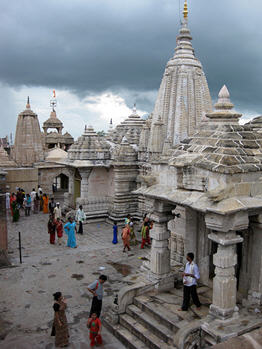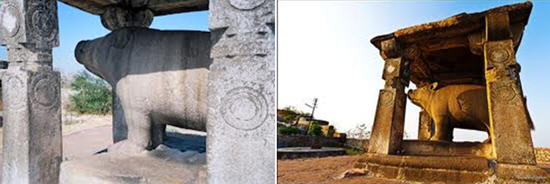
After an hour of country riding from Nagpur railway station by vehicle, one arrives at the foothills of Ramtek or Ramgiri.
Riding through the narrow lanes of merchants and farm animals, one can drive on the twisting road up the hill to the peak of Rama Giri. One can also walk through the steps on the mountain.
As the last curve of the road widened to the top, one can find standing before the steep rock wall of Rama Giri fort. This fort was built several centuries ago by kings of the Bhonsle clan. Rama Giri was chosen as the fort’s site for two reasons: (1) strategically, the hill offers a 360-degree view of the surrounding area, which it was the kings’ duty to protect, and (2) Vedic kings, even as late as the eighteenth century, were impelled by their burning religious convictions to guard holy areas.
In 1827, however, after the Bhonsle warriors suffered defeat at the hands of British invaders at the Battle of Sitalbuldi, their reign over the area rapidly deteriorated. Today the fort with its old tanks and temples is a protected monument, a historical oddity frozen in time.
1) The huge, rare deity of Lord Visnu-Varaha:

Overlooking the valley and the fort, this is one of rarest giant Varaha deities weighing several tons. There are two Varaha temples in Mathura, ancient ones visited by Lord Sri Caitanya Mahaprabhu, as documented by “the king of poets” Krishnadasa Kaviraja in his most inspiring Sri Caitanya-caritamrta. There is also a beautiful white marble deity of Lord Varaha worshiped in a fine temple along the shores of Pushkar Lake in Rajasthan. But the only other deity of Lord Varaha of this immense size is the svayam-bhu (“self-manifested”) Sri Visnu-Varahaji of Majholi, Madhya Pradesh.
2) The ashram of Agastya Muni.:

Lavishly preserved in marble and carefully maintained by a group of devoted sadhus, the hermitage has been developed as a pilgrims’ destination of much importance. Even the yajna-sala, the holy place of fire sacrifice where the rsi received Lord Rama, has been continuously maintained since Treta-yuga. An iron door has been installed over Agastya’s deep cave of meditation; only select yogis are allowed entrance into the chamber, called Hatiphor. The ashram’s astute crew of ascetics display extreme care in the upkeep and worship of Saint Agastya’s shrine. Their devotion reveals that they have correctly understood the place’s Puranic significance.
Beyond Agastya Muni’s peaceful cave is a large group of temples, the first of which is dedicated to Laksmana, who led the way to Rama Giri, announcing to the sages the arrival of his brother and sister-in-law. This explains why the Laksmana Mandir is first. The other temples are separately dedicated to Lord Rama, Goddess Sita, and Bhakta Hanuman.
3) The Deities in the Main Temple:

The local history of the Deities is noteworthy. In 1736 King Raghu Bhonsle visited Rama Giri only to discover that just the padukas or wooden sandals of Lord Rama were being worshiped. The deities were no longer present. The king vowed to commission Jaipur deities for the temple. But once the sacred murtis were prepared for temple installation prana-pratistha the king had a dream in which Lord Rama told him to search under the waters of the River Sur a few miles north. Finally, in 1753, the original deities were discovered and re-installed atop Rama Giri amidst much festivity and celebration. The Jaipur deities are privately cared for in a reserved area.
4) Ambala Kund:

This lake below the hill is said to have been named for King Amba, who was cured of a terrible disease after his bath in these waters, which originate from an underground river called Patala Ganga.In the eighteenth century, King Raghu Bhonsle had the lake and many of the shore temples renovated with fine stone work. These temples include those of Jagannatha, Pancamukhi Mahadeva (“five-faced Siva”), and Surya Narayana (the Sun incarnation of Visnu).
NOTE: Devotee-pilgrims who would like to visit Ramtek and Rama Giri may make arrangements with the devotees at ISKCON Nagpur’s SriSriRadha-Madhava Temple.
Location :

The temple is located on the Ramgiri Hill situated in Ramtek, which is 42 km northeast of Nagpur city, Maharashtra. One can travel by car up to the entrance of the temple on the hill.
